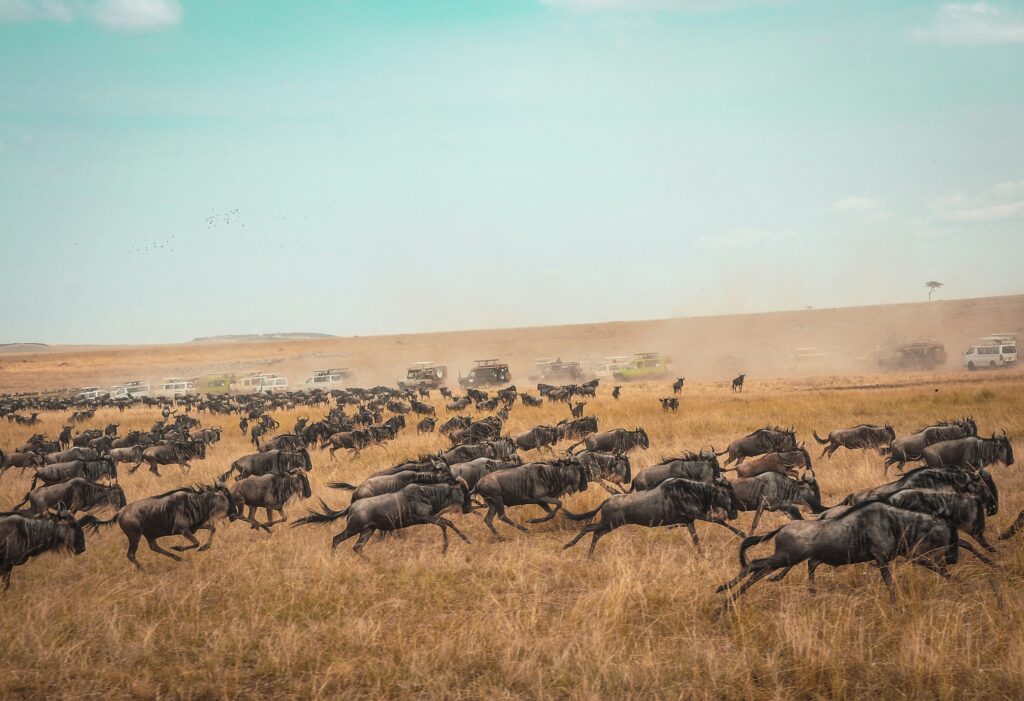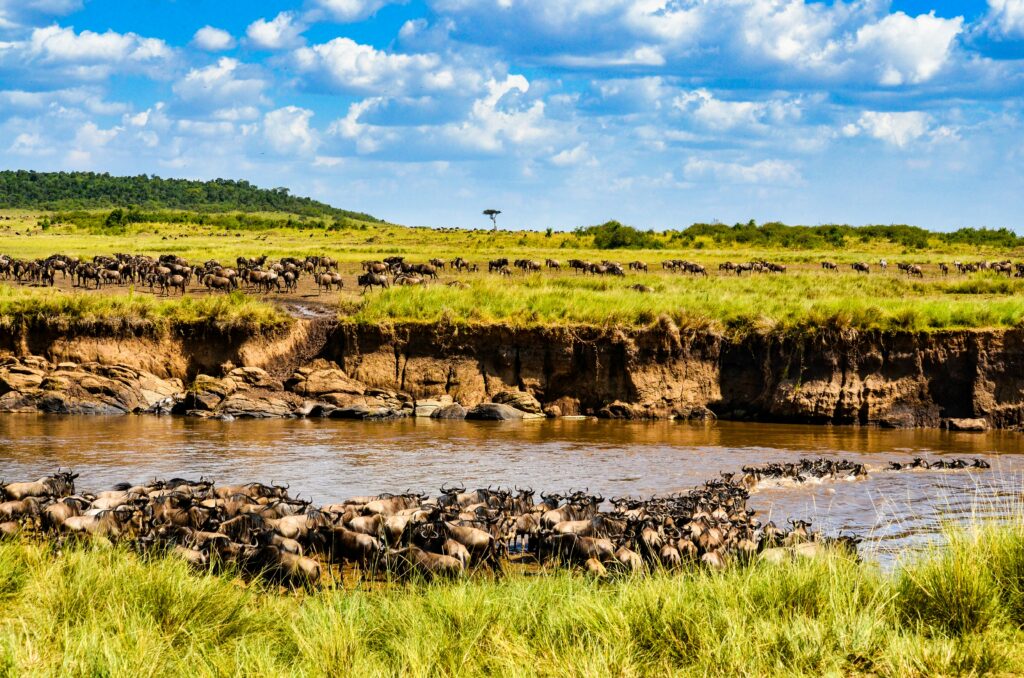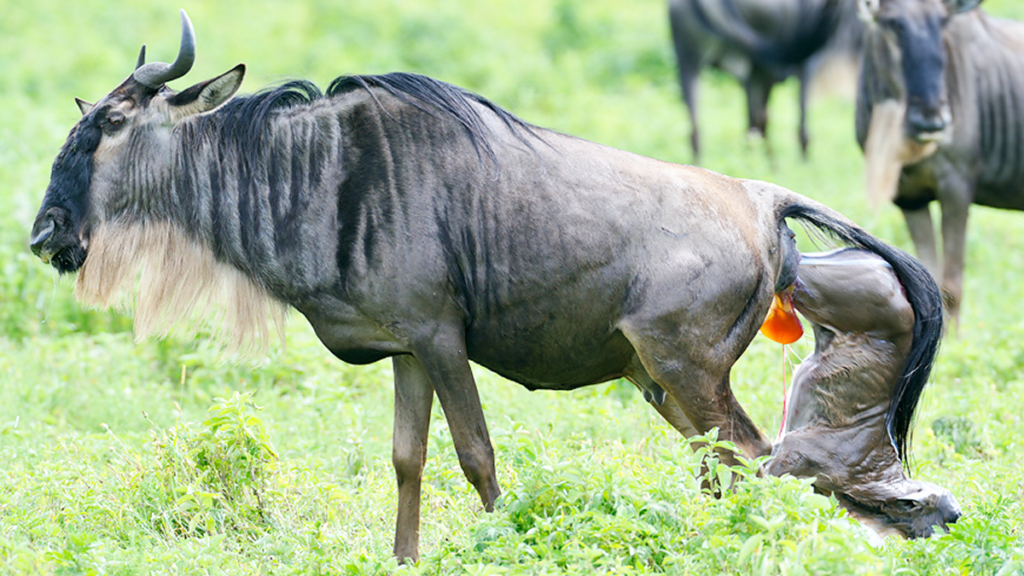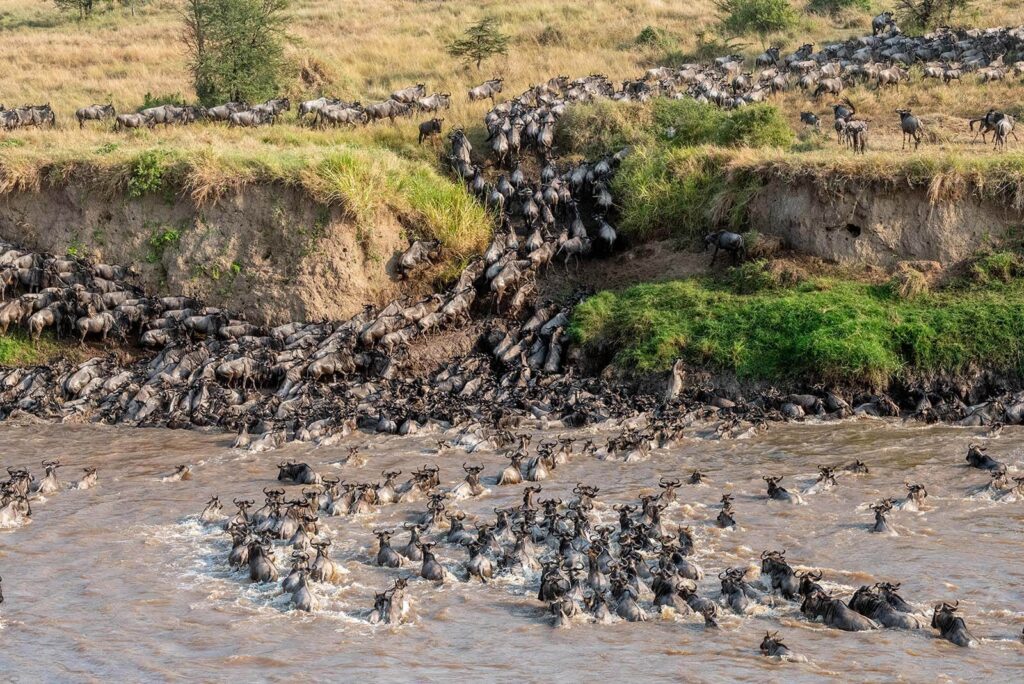Have you ever wondered about one of nature’s most spectacular event, the Great Wildebeest Migration? And asked yourself could there ever be a one-stop shop excellent reference for anyone struggling with finding an easy, compact, and handy guide to a spectacle that defies words and leaves even the most seasoned traveller in awe, the Great Wildebeest Migration.
This incredible phenomenon, often described as the greatest wildlife show on earth, captivates the hearts and minds of nature enthusiasts and photographers worldwide. Over a million wildebeests, accompanied by thousands of other ungulates, embarking on an epic journey across the Serengeti-Mara ecosystem in Tanzania and Kenya.
The Mystery of Wildebeests: WHAT IS THE GREAT MIGRATION?
The Great Wildebeest Migration is nature’s masterpiece, showcasing the age-old rhythm of life and survival in the animal kingdom. It is the perfect textbook definition of the saying ‘‘the grass is always greener on the other side’’. More than a million wildebeests, joined by a cast of thousands including zebras, Thompson gazelles and Grant gazelles, embark on an odyssey that reveals their primal instincts, leading them on a journey guided by the search for short greener pastures and reliable water sources. This annual movement covers more than 800 kilometres (500 miles) as the herds traverse the Serengeti-Mara ecosystem.
The majority of this magnificent migration unfolds within Tanzania’s Serengeti National Park, with a smaller portion crossing into Kenya’s Masai Mara National Reserve from late September to mid-November. Here, the savanna plains come alive with a sea of animals stretching as far as the eye can see and your camera lenses can capture. More than just a river crossing, the migration is a symbol of life, death, and the eternal cycle of nature. The wildebeest migration isn’t just a journey; it’s a pilgrimage guided by ancient instincts and the promise of greener pastures, coupled with devastating challenges en route, yet the migrating herds will still migrate again the next year.

The untold Secrets of the Migration: WHY DOES THE GREAT MIGRATION OCCUR?
The question often arises: Why do these thousands of wildebeests leave their open grassland plains for a perilous journey? The simple answer is – The wildebeest migration is associated with the rains that bring about newly sprouting grass.
The more complex answer lies in their unique physiology and the ever-changing landscape of the savanna. Wildebeests, with their distinctive wide mouths designed for grazing, are pure grazers. Their diets consist primarily of short, nutritious grasses, and their large bodies require a substantial daily intake. However, their dependence on short grass 15 cm long or less specific grasses (caring little about the specific part of the plant or species) and the need for regular access to water force them to migrate.
As the seasons change, so do the availability of these resources. In desperate moments of a year, wildebeest may be forced to temporarily resort on leaves from tall stems but not for long. Their ideal habitat lies in the Serengeti-Mara ecosystem, where the balance of moisture and grass quality is just right. This explains why wildebeests are not as prevalent in areas with excessive rain, as they are finely attuned to the short nutritious grasses unique conditions.

Embarking on Nature's Grand Journey: WHAT IS IT ABOUT THE WILDEBEEST MIGRATION THAT CAPTIVATES US?
The allure of the Great Wildebeest Migration extends beyond its sheer size and spectacle. It’s a saga of survival, with each animal playing a crucial role in the ecosystem. Here’s why this event captivates us:
Forever unfolding drama: Wildebeests are one of the most fascinating mammals to watch on a safari as they are almost always doing something worth watching if you know what to look for. Whether its herds leaping into steep river banks and crocodile-infested waters or the intense calving season scale or chasing the distant rains, captivating drama is ever-present at every turn during the migration.
Ecological Significance: The great wildebeest migration is not just a spectacle to watch that amazes travellers; it serves an important ecological function. The wildebeests’ movement helps replenish the grasslands by stimulating new growth. They are a vital food source for predators, contributing to the delicate balance of the Serengeti Mara ecosystem. Wildebeest are a true delicacy and a favourite prey for lions, due to their abundance and hunting ease. However, the spotted hyena, a master of the hunt, causes a significant number of wildebeest death compared to lions or crocodiles during the crossing. A true opportunistic predator, that take down both fit and unfit adults as well as a huge number of calves who fall victim. Wild dogs and leopards also pray their part when the herds reach the open woodland areas.
Interacting with wildlife in a purest state: – A vast, untamed wilderness where the rhythm of life beats with the hooves of a million wildebeests, this migration is truly extraordinary and it is visible from space. Hypothetically, you may not be able to visit space, realistically, you can see the migrating columns at a vantage point in a bird’s eye view on a balloon. Witnessing a wildlife Olympic marathon of the herds covering nearly 40 kilometres per day and about 800 kilometres (500 miles) of distance in the great wildebeest migration cycle, right from the stadium of Serengeti plains to the Kenya Masai Mara.
Action-Packed Thrills: On the course of the journey, you will witness a life cycle of more than 250,000 wildebeests and 30000 zebras perish, falling victim to predators, exhaustion, stampedes, drowning, thirst, and hunger. In the end, granting an opportunity to nature’s clean-up crew “Vultures” do what they do best, scavenge on all the fallen victims.
Wonder of the world: From the rutting season to the river crossings, each phase offers a front-row seat to nature’s grandeur. The great wildebeest migration is one of the Seven Wonders of the World and the number One Wonder of Africa. You will eventually get to witness more than half a million calves being born in a short period and perhaps a calf-feeding bonanza by predators on the Serengeti National Park plains

Wildebeest 101: A Closer Look Wildebeests: The Powerhouses of the Plains
Famously known as the “spare part animal” for its peculiar looks and unique features. The sloped back body of a hyena, legs of an antelope, stripes of a zebra, horns of a juvenile cape buffalo, tail of a horse, face of a baboon/grasshopper, rump of a donkey and brains of whatever you would like to call it. Some have gone further into grouping wildebeest into a group called the “ugly five” (A talk for another day). Regardless of having disproportionally large forequarters and a heavy body that depicts a more bovine cow-like look, wildebeest are members of the antelope family, they are related to gazelles and oryxes. Wildebeest also known as gnu is a creature of incredible power and resilience. Despite its seemingly awkward appearance, the wildebeest’s anatomy is finely tuned for its migratory lifestyle.
Stamina and Endurance: Wildebeest are the most reliable source of food for the Serengeti-Mara ecosystem apex predators, despite their awkward appearance, wildebeests are not weak prey. As their name “Wildebeest” or Wild beast” was earned from the menacing appearance of their large head, shaggy mane, pointed beard and sharp curved horns. Their bodies were genetically modified to accommodate their migratory behaviours. Heavily built with disproportionately large forequarters can reach 8 feet in length, 4.5 feet tall at the shoulders, and weigh up to 270 kilograms/6000 pounds with sharp horns in both sexes. Their disproportionately large forequarters, shoulders positioned high, and long front legs with a slanted back allow them to canter long distances in an energy-efficient locomotion fashion pace that is faster than walking but also not as tiring as running ‘‘style trotting’’.
Group Intelligence: At first sight, you might think the migrating herds move in a frenzy but research has it that herds of wildebeest’s herds exhibit “swarm intelligence,” exploring, maintaining contact, coordinating movements and overcoming obstacles together. Even at night time, they bed down in columns for group security in a way that allows individuals to escape when deterred without interference.
Precocious Calves: Wildebeest calves are born ready for the journey ahead, standing within minutes, and keeping pace with the ever-moving herds in the glassy plains shortly after birth. This can directly be associated with the presence of lurking danger from the precise moment they are born.
Synchronized Calving: An immense to-burst short calving season might be thought as a poor tactic with such an aggregation of predators around. However, it’s an ingenious solution, producing 90% of calves 3 weeks early in the rains. The more calves present the better the chance for others to survive. Granting precious time for the new-born calves to gain strength and firmly be imprinted on their mother while the predators are kept busy with the older calves.
Zebras, The Partners in Crime: Zebras and wildebeests are not only companions in migration but also allies in survival, with each species offering unique advantages in the wild. Zebra herds are great at sporting threats due to their good eyesight while wildebeest have a remarkable sense of hearing and smell helping them both in combined protection against predators and searching new pasture grounds
Single Profile Walk: Wildebeest often walk in a single line with their heads hanging low, following scent marks to navigate through the open grassland. This is believed to be the most efficient, quickest, and safest way to track their established pathways to water, trek to and from feeding grounds. The scent glands are located between their front hooves.

Witnessing Nature's Symphony: BEST TIME TO WITNESS THE MIGRATION
So, when is the best time to witness this grand spectacle, your front-row seat? Whether you seek the thrill of the river crossings or the serene beauty of the calving season, each month offers a unique experience. As the wildebeest migrate, they create a symphony of life and death, survival and sacrifice. From the synchronized calving season to the thunderous rutting behaviour, each phase is a chapter in nature’s epic saga. Determining when to travel and witness this visually stunning animal migration depends on what event of the migration you want to experience.
The Great Wildebeest Migration is a year-round spectacle, with each month offering a different highlight:
December – March: The Calving Season:
Witness the miracle of half a million calves born on the lush plains, attracting predators and showcasing synchronized calving.
April – June: The Trek North and the Rut:
Herds move north, grazing and engaging in spectacular rutting behaviour, a sight to behold.
July – October: The River Crossing:
The iconic river crossings at the Mara River present a thrilling, albeit perilous, spectacle as wildebeest’s brave crocodile-infested waters.
November: The Trek South:
The herds make their way back south, completing the cycle and preparing for the next calving season.
The Calving Season (December - March)
Marvel at the miracle of life as half a million calves are born on the lush plains, attracting predators and showcasing nature’s cycle of birth and death.
The wildebeest returns in the eastern edges of Serengeti National Park into the Ngorongoro Conservation Area. Feeding on lush green grass specifically rich in calcium, potassium, and phosphorus essential minerals for the pregnant mothers and the newly born calves. The calving season is a spectacle of nature where half a million calves are born within a short period, providing a super abundant feast for the aggregation of Serengeti predators.
In just three weeks, half a million calves are born in the Ngorongoro Crater highlands and around Olduvai Gorge in the Ndutu area, an equivalent of 24,000 thousand calves a day and a thousand calves an hour. Every morning dozens of offspring’s are produced ending by midday allowing them to gain strength before danger lurks in the night. This period is marked by intense predator-prey interactions, predators gather to exploit this abundance of vulnerable calves, using different tactics to make the most of the abundance. Wildebeest calves are precocious and can walk, trot, and run in just 3 minutes an average of the minutes
after birth and keep pace with the running herd. The mother sees through it by not breastfeeding the calf until it can find its feet steadily and is imprinted on her mother.
This is also prime time for bird-watching enthusiasts as migratory birds are found in numbers also making the most out of the short rainy season.

The Trek North and the Rut (April - June)
Experience the herds’ northward journey, marked by spectacular rutting displays and the promise of new horizons.
This period is full of drama as the herds congregate and feed in vast numbers, preparing for the challenges ahead. After the calving season, the wildebeest herds have grazed the land bare. The once rich in fertile grass plains become depleted, unable to harbour the endless herds. Amid April, the migration gains momentum and treks northwest, stretching wider into central Serengeti in search of fresher pastures. Drawing with them their partners in crimes in thousands of zebras and scattering numbers of gazelles. The herds disperse and stretch much wider covering several kilometres. Huge herds can be seen grazing shoulder to shoulder without hindrance and interference in their largest concentration.
The rut begins in May, ‘‘Bullfrog’’ calls chorusing noise made by thousands of territorial bulls coinciding with herding, chasing, and battling head-to-head marks an epic spectacle of nature. A rut of this magnitude is one of the world’s spectacular wildlife behaviours on the planet, the aggregation intensifies the drama and competition. An estimated 250,000 bulls become temporary territorial and are expected to serve 750,000 cows in a three-week duration peak.
As the dry season progresses in June, the herds match in columns to the Western corridor of Serengeti, congregating on the southern banks and pools of the Grumeti crocodile-infested river. Where they will face their first river crossing challenge, a glimpse of what is to come.
The River Crossing (July - October)
Hold your breath as wildebeest’s brave crocodile-infested waters in the iconic river crossings. It’s a scene straight out of a wildlife documentary, unfolding before your eyes.
Upon the arrival of July, the dispersed herds have exhausted all best pastures in the western corridor and carry on matching north in northern Serengeti. Gathering and spreading out all across the northern the banks of the most serious obstacle of the migration, the Mara River that flows through northern Serengeti from Masai Mara National Reserve in Kenya.
The most iconic and treacherous part of the migration is the river crossing. The herds face the daunting task of crossing crocodile-infested Mara River in search of greener pastures in Masai Mara National Reserve. Witnessing the river crossing is an adrenaline-pumping experience, with wildebeests risking their lives to reach the other side.
In the wildebeest open society system any wildebeest brave enough to lead the way becomes the leader. Follow the leader tendency allows multiple routes in the crossing action, as some herds will cross shallow
waters successfully, some will drown in the turbulent and surging currents, steep banks will claim a good number of broken legs and torn muscles.
Nile crocodiles lurking underneath claim their share with powerful jaws, while other opportunistic predators patrol and monitor the banks on both sides of the river, capitalizing on the stragglers and the weak. The herds will witness massive losses on crossing, at some point, even the Crocodiles that have not eaten in months will have their fill. Lush grazing grass stretching across the Masai Mara is the reward for the wildebeest that makes it across.
The river crossing is a natural phenomenon, with herds knowing what to do at what moment. It is common to see wildebeests crossing the Mara River/Talek River, and later or in just a couple of hours or a few days later cross back, all depending on how they read the weather.
By August, the herds have spread throughout the Masai Mara northern region and in September, they concentrate in the northernmost side of the circle

The Trek South (November)
As the year comes full circle, the herds begin their trek back south, completing the cycle and preparing for the next chapter.
In the late October and November, the herds brace for the treacherous Mara River, which claimed many of them once again. The herds start their journey back south towards the Serengeti, completing their annual migration cycle. The trek south is marked by renewed grazing opportunities brought about by the short rains. The herds spread out in the eastern and southern reaches of the Serengeti Namiri plains (famous cheetah grounds), preparing for the calving season once again. The year-round migration cycle of wildebeest, zebras, and gazelle’s starts all over again, encountering friends and foes as they roam.
Nature's Grand Drama Tips for Planning Your Great Wildebeest Migration Adventure
Planning for the Great Wildebeest Migration requires careful consideration. By following these tips, you can ensure a memorable and safe adventure as you witness one of nature’s most incredible spectacles. Get ready to be awed by the drama and beauty of the migration with these handy planning tips!
Choose the Right Time to Visit: It is important that you decide which phase of the migration you want to experience – the calving season, the trek, the river crossing, the rutting season or all of them. This aligns with researching the peak times for each event to plan your visit accordingly. Different phases of the migration occur at different times of the year. Keep in mind that peak times can be crowded, so if you prefer a more private safari experience, consider visiting during shoulder seasons.
Select Your Safari Type: Decide whether you want to go on a guided safari or a self-drive adventure. Guided safaris offer expert guides and comfortable accommodations, while self-drive options provide more flexibility and independence. Compare safari packages and their costs to find one that fits your budget. Remember to include accommodation, meals, park fees, and transportation in your budget planning.
Stay Informed: Consider consulting with wildlife experts or tour operators who specialize in the Great Wildebeest Migration for insider tips and advice. Follow wildlife reports and updates on migration patterns to ensure you’re in the right place at the right time.
Choose Your Accommodation: Consider staying in lodges or tented camps within or near the national parks. Lodges offer more amenities and comfort, while tented camps provide a closer connection to nature. Accommodations near popular migration spots fill up quickly, so make reservations well in advance to secure your preferred lodging.
Prepare for Wildlife Viewing: Pack binoculars and cameras with zoom lenses to capture close-up shots of the wildlife, especially during river crossings and predator-prey interactions. Wear neutral-colored clothing for wildlife viewing and pack layers for varying temperatures, especially during early mornings and evenings. Don’t forget essentials like sunscreen, insect repellent, hats, and comfortable walking shoes for game drives and bush walks.
